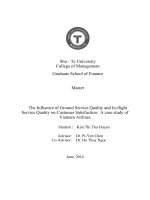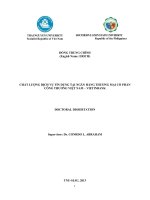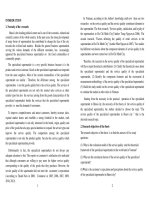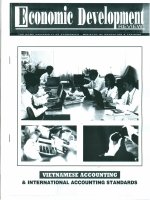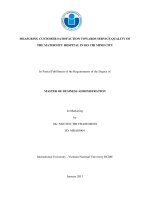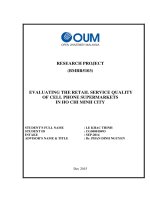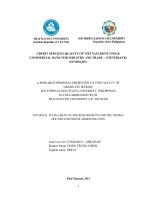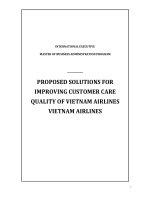Service quality of vietnam airlines
Bạn đang xem bản rút gọn của tài liệu. Xem và tải ngay bản đầy đủ của tài liệu tại đây (786.6 KB, 26 trang )
lOMoARcPSD|9890249
Service Quality of Vietnam Airlines
Productivity & Quality Management (Trường Đại học Ngoại thương)
Studocu is not sponsored or endorsed by any college or university
Downloaded by K60 Tr?n Tu?n Hùng ()
lOMoARcPSD|9890249
QUALITY MANAGEMENT & PRODUCTIVITY
SERVICE QUALITY OF
Vietnam Airlines
LECTURER
Assoc Prof Dr Le Thai Phong
.
.
.
GROUP 4
Tran Khanh An 1810280002
Nguyen Minh Cong 1815280031
Pham Trung Dung 1810280006
Le Huong Giang 1812280037
-
-
-
-
Downloaded by K60 Tr?n Tu?n Hùng ()
lOMoARcPSD|9890249
Table of Contents
1. Service Quality.......................................................................................................................................... 2
1.1. Definition ........................................................................................................................................... 2
1.2. Service Quality Measurement ............................................................................................................ 2
1.3. Standards of aviation service quality ................................................................................................. 2
2. Introduction of Vietnam Airline ............................................................................................................... 3
2.1. Foundation ......................................................................................................................................... 3
2.2 Market share........................................................................................................................................ 4
2.3. Outstanding features in service quality .............................................................................................. 4
2.4. Business Performance ........................................................................................................................ 5
3. Methodology ............................................................................................................................................. 6
3.1. Secondary data ................................................................................................................................... 6
3.2. In-depth Interview & Observation ..................................................................................................... 9
4. Data Analysis .......................................................................................................................................... 11
4.1. Secondary Data ................................................................................................................................ 11
4.1.1. Examine validity of secondary data through Cronbach’s alpha and EFA ................................ 11
4.1.2. Descriptive data......................................................................................................................... 13
4.1.3. Multiple linear regression analysis............................................................................................ 13
4.2. IDI & Observation ........................................................................................................................... 16
5. Recommendation .................................................................................................................................... 20
1
Downloaded by K60 Tr?n Tu?n Hùng ()
lOMoARcPSD|9890249
1. Service Quality
1.1. Definition
● Service quality is a concept that has stimulated considerable interest and debate in research
literature because of the difficulties in both defining and measuring it, with no consensus
on either (Wisniewski et al., 1996).
● Service quality is defined as the context to which a service meets customers’ needs or
expectation (Asubonteng, 1996)
1.2. Service Quality Measurement
The most popular measure of service quality is SERVQUAL, an instrument
developed by Parasuraman et al. (1985; 1988). SERVQUAL shows its best valuation when it is
used to track service quality trends as well as in combination with other forms of service quality
measurement. Moreover, SERVQUAL is used to evaluate the firm’s quality according to the five
services dimensions. These dimensions include Reliability, Assurance, Tangibles, Empathy
and Responsiveness (RATER model).
● Reliability: The ability to perform the promised service dependably and accurately.
● Assurance: The knowledge and courtesy of employees and their ability to convey trust
and confidence.
● Tangibles: The appearance of physical facilities, equipment, personnel and
communication materials.
● Empathy: The provision of caring, individualized attention to customers.
● Responsiveness: The willingness to help customers and to provide prompt service.
1.3. Standards of aviation service quality
Nowadays, customer satisfaction is regarded as one of the most indispensable elements
playing a vital part in determining the success and prosperity of a specific business in such a
dynamic and fast-growing market. According to Rust and Oliver [16], customer satisfaction is
defined as an emotional or affective response which surfaces and develops when meeting with any
kind of service. After service is provided, a positive or negative reaction will emerge from
customers getting that service. Also, Oliver [13] stated that “customer satisfaction is the outcome
2
Downloaded by K60 Tr?n Tu?n Hùng ()
lOMoARcPSD|9890249
of the evaluative process between the impression during or after service is performed and the
expectations before experiencing the service.” In specific situations, what people assume before
using the service may contradict what we actually encounter during and after the service is
performed.
In transportation context, the fact that passengers are satisfied with the services provided
has a crucial effect on determining the long-term continuance of a specific carrier. Dissatisfied
passengers may lose their trust and not consider choosing the same airline again due to the bad
service provided. Therefore, it is imperative for airlines to assure what customers expect and
experience with their desired service quality. We choose customer satisfaction as a measurement
for service quality of VNA
2. Introduction of Vietnam Airline
2.1. Foundation
● Founded in 27th May, 1995, Vietnam Airlines is the national airline of Vietnam and
majority-owned by the Vietnamese government. Vietnam Airlines is the flag carrier of
Vietnam and the major carrier in South East Asia, operating 94 routes to 22 domestic and
29 international destinations with an average of 400 flights per day
● Vietnam Airlines became a member of SkyTeam in 2010, reaffirming the carrier’s position
on the global aviation map.
3
Downloaded by K60 Tr?n Tu?n Hùng ()
lOMoARcPSD|9890249
2.2 Market share
The figures published by the Civil Aviation Authority of Vietnam revealed that the
Vietnamese aviation market saw noticeable changes in 2019. VNA witnessed a slight decrease in
its market share due to the expansion of of private carriers
Vietnam Airlines saw a drop to 33.3 percent in market share in December 2019, from
approximately 34.5 percent at the beginning of the year.
Jetstar Pacific and VASCO (2 subsidiaries companies of VNA group) respectively held
market shares of 10.6 per cent (down from 14.2 per cent at the beginning of the year) and 1.6 per
cent (down from 2 per cent).
2.3. Outstanding features in service quality
● The majority of flights take off on time. The frequency of delayed flights is relatively low.
4
Downloaded by K60 Tr?n Tu?n Hùng ()
lOMoARcPSD|9890249
● Secondly, you don’t have to pay extra for Additional services( snacks, drinks) are included
in the tickets.
● VNA offers up to 20kg of check-in luggage free of charge, while you have to pay an extra
fee for this item while experiencing other low-cost airlines .
● Large investment in refurbishment to provide customers with luxurious and comfortable
experience.
2.4. Business Performance
Total
number
of
flights
Passengers carried
Cargo
and
2015
2016
2017
2018
2019
2020
Thousand
122,8
131,2
141,7
141,3
146,2
95,8
-34,47%
Million
17,4
20,7
21,9
21,9
22,9
14,1
-38,43%
208,4
271
323
341,5
348
196
-43,68%
32,8
34,8
36,2
37,6
15,2
-59,57%
35,8
40,6
42,7
44,7
46,5
19,4
-58,28%
80,7
80,8
81,5
81,3
80,9
78,25
-3,28%
mail Thousand
carried
tons
Revenue passengerkilometers (RPK)
Available
Growth rate
UNIT
(2019-2020)
Billion
passengers. 28,7
km
seat- Billion
kilometers (ASK)
seats.km
Load Factor
%
Business Performance of Vietnam Airlines from 2015 to 2020
As can be seen from the table, VNA experienced a significant drop in every aspect of
business performance due to the negative impacts of Covid-19 pandemic. The total number of
flights decreased considerably from 146,2 thousand to 95,8 thousand with the percentage of
34,47%%. In terms of passengers carried, the national airlines carrier witnessed a substantial fall
with the rate of 38,43%. Other metrics such as cargo and mail carried, RPK, ASK and load cargo
also shared a downward trend.
5
Downloaded by K60 Tr?n Tu?n Hùng ()
lOMoARcPSD|9890249
In conclusion, in the context of the pandemic, VNA has lost a large number of nondomestic passengers and its market share due to the expansion of cheap private airlines. Therefore,
in order to maintain the loyal domestic customers, VNA should take drastic measures to enhance
its service quality
3. Methodology
Step
Output
Determine 2 dimensions
1. Refer Empirical Article: "Customer
that mostly affect
satisfaction of Vietnam Airline domestic
customer satisfaction of
service quality" by Giao Ha Nam Khanh
VNA
2. Conduct IDI and Observation
Issues and solutions
related to 2 chosen
dimension,
recommendation from
customer insights
Objective
Ensure the validity and
reliability
Find out what aspect of
service quality affects
customers
Digging deeper into 2
chosen dimensions and
other issues for better
understanding
3.1. Secondary data
Variables Framework
A quantitative analysis was conducted to test the hypotheses. This research applies
modified criteria for measuring customer satisfaction with aviation service quality offered by
McGraw-Hill survey for North American airline satisfaction in 2010 to the case of VNA in which
aviation service quality comprises six determinants: (1) reservation (RES), (2) check-in (CHE),
(3) aircraft (AIR), (4) in-flight services (INF), (5) flight crew (FLI), and (6)
boarding/deplaning/baggage (BDB). In-depth interviews with three high-ranking VNA officials
are conducted to identify determinants of service quality and evaluating criteria. The interviewers
are followed by a group discussion based on open questions with seven passengers who frequently
use VNA domestic services in order to find their perception of determinants of service quality.
Their opinions are used for improving and developing scales for aviation service quality.
6
Downloaded by K60 Tr?n Tu?n Hùng ()
lOMoARcPSD|9890249
Population and sampling
The target population includes Vietnamese passengers who are in the 18–60 age bracket
and used VNA domestic services two times at least in the last 6 months. The sample size and
sampling result are presented in Table 1.
7
Downloaded by K60 Tr?n Tu?n Hùng ()
lOMoARcPSD|9890249
Data Gathering
A structured questionnaire with 5-point Likert scales with anchors “strongly disagree” to
“strongly agree” was used in this study. The questionnaire consisted of two parts. The first part
was to examine the customer satisfaction through the variables of service quality. The second part
was designed to collect respondents’ demographic information. To validate the questionnaire, a
pilot test was carried out on a convenient sample of 30 passengers and the collected data was used
to refine the survey instrument. A quantitative survey is conducted in Tan Son Nhat Airport.
Analysis Method
After collecting the data, a statistical package for social sciences (SPSS, 22 versions) was
used for analyzing the data. Cronbach’s alpha and exploratory factor analysis (EFA) were
employed to test the reliability and validity, and then multiple regression analysis was performed
to test the hypotheses. Subsequently, the tests of regression assumptions and difference tests
consolidated the findings.
8
Downloaded by K60 Tr?n Tu?n Hùng ()
lOMoARcPSD|9890249
3.2. In-depth Interview & Observation
It was unable to interview offline during that time due to COVID-19 pandemic prevention
and control requirements. As a result, interviewing via video call was the only method to collect
data. All the questions were unbiased, easy to understand, and courteous as well as avoiding
confusion for participants. We also use observations from Tipadvisor and Airlinequality so that
the results are closer to the Covid context and have more foreign visitors' perspectives. Limitation
of this research is that we mainly focus on economy class’s issues and solutions.
Objective
● Digging deeper into 2 dimensions: BDB (Boarding/Deplaning/Baggage) and CHE (Checkin)
● Insight about service quality
● Find a basis for recommendations
Content
● Brand perception
● Flight experiences and issues related to BDB and CHE
● Demand, desire and barrier
Sample: base on sample of Secondary Data
Sample Size: 10
Geographical: Hanoi, Saigon, Da Nang
Gender
Age
Income (per month)
Purpose
N
Male
4
Female
6
From 18 to 33
5
≥ 34–46
4
47–60
1
≤ 5 million VND
2
6–9 million VND
1
≥ 10 million VND
7
Business
3
Leisure
7
9
Downloaded by K60 Tr?n Tu?n Hùng ()
lOMoARcPSD|9890249
Questionnaire Design
Criteria
Main Points
Tuổi
Nơi sinh sống
Demographic Nghề nghiệp
Thu nhập
Các kênh thông tin thường xem
Tần suất bay?
Flight
behavior
Thường bay với mục đích gì? Công tác hay du lịch?
Thường chọn hạng vé nào? (với tùng mục đích bay, độ dài chặng bay)
Thường mua vé máy bay ở đâu?
Hay đi hãng bay nào nhất? (nội địa/quốc tế, tùy độ dài chặng bay)
Lý do chọn hãng bay đó?/Lý do khơng chọn VNA?
VNA
perception
Để miêu tả VNA thì nghĩ đến những từ gì hoặc đặc điểm gì?
Bạn có ấn tượng gì về đồng phục, logo và màu sắc thương hiệu của VNA so với
các hãng khác? Vì sao
Khi lựa chọn hãng bay, bạn quan tâm đến yếu tố nào nhất (theo thứ tự giảm dần):
BDB, CHE, INF, RES, AIR, FLI
Nghĩ gì về chất lượng dịch vụ của VNA?
Đánh giá chất lượng dịch vụ của VNA (theo thứ tự giảm dần): BDB, CHE, INF,
RES, AIR, FLI
Flight
experiences
& Issues
Bạn có gì chưa hài lịng trong q trình Check in ko? So sánh với các hãng bay
khác (Thủ tục check-in, Staff, Baggage drop, Waiting times)
Bạn có gì chưa hài lịng trong q trình Lên máy bay / Hạ cánh / Ký gửi, Nhận
Hành lý ko? So sánh với các hãng bay khác (Xử lý khi delay, phịng chờ, thay đổi
thơng tin cửa khởi hành, Hành lý được bảo đảm) Bạn có khó tiếp nhận thơng tin
trong trường hợp chuyến bay có sự thay đổi ko?
Đã từng có trải nghiệm ko tốt nào, vấn đề gì khác khi bay VNA ko? (optional)
10
Downloaded by K60 Tr?n Tu?n Hùng ()
lOMoARcPSD|9890249
VNA có thể cải thiện điều gi để nâng cao trải nghiệm KH?
Mong muốn VNA có thêm dịch vụ gì ko?
Demand,
desire and
barrier
App Lotusmile nên bổ sung những tính năng gì để thu hút người dùng?
Tiêu chuẩn mà bạn đặt ra cho VNA có cao hơn các hãng hàng khơng Việt Nam
khác ko? Tại sao?
Bạn định nghĩa thế nào là một hãng hàng khơng 5 sao?
Với những tiêu chí trên thì cho VNA mấy sao?
4. Data Analysis
4.1. Secondary Data
4.1.1. Examine validity of secondary data through Cronbach’s alpha and EFA
11
Downloaded by K60 Tr?n Tu?n Hùng ()
lOMoARcPSD|9890249
Table 4.1. Cronbach’s alpha coefficients for scales of determinants of quality service
and customer satisfaction
Table 4.1.2. EFA results
Table 3 shows that Cronbach’s alpha coefficients of all scales are greater than 0.6 and all
item-total correlation coefficients are greater than 0.3. Thus, all scales are reliable
and can be used for EFA. In the EFA process, principal determinant analysis and Varimax are
employed. EFA results show that KMO = 0.888 while the chi-square statistic of Barlett’s test
reaches 7298.249 at Sig. = 0.000. All 31 determinants are reduced to seven factors with an
eigenvalue of 1.041 (greater than 1) with a variation of 66.42% (able to explain 66.42% of changes
in the dataset). Observed variables of seven factors all have factor loadings greater than 0.5, and
they are used for analyzing the research model of multiple linear regression. Thus, resultant scales
are acceptable. After conducting the factor rotation with all 31 aforementioned variables, seven
factors are extracted (Table 4). EFA results show that scales measuring customer satisfaction and
determinants of service quality did obtain convergent validity. The results also imply that the
research model remains stable, comprising six independent variables and one dependent variable.
12
Downloaded by K60 Tr?n Tu?n Hùng ()
lOMoARcPSD|9890249
4.1.2. Descriptive data
Table 4.2. Passengers’ estimates of determinants
Results of estimation of determinants of aviation service according to the statistical method
describing the mean value in a 5-scale Likert show that scores given by passengers vary from
“medium” to “pretty good”(Table 9). The highest scores are given to reservation (mean = 3.60),
followed by in-flight services (3.56) and flight crew (3.51), while medium scores are given to
aircraft (3.47) and boarding/deplaning/baggage (3.40) and the lowest one to check-in (3.31); SAT
is given a pretty high score of 3.41.
4.1.3. Multiple linear regression analysis
13
Downloaded by K60 Tr?n Tu?n Hùng ()
lOMoARcPSD|9890249
Table 4.3. Correlation coefficients between determinants
Table 5 shows that the dependent variable has a close linear relation with six independent
variables at α<0.05. Because all absolute correlation coefficients between variables vary from
0.245 to 0.671, thus satisfying condition −1≤r≤+1, all variables are qualified for multiple linear
regression analysis. This demonstrates that the discriminant
validity is achieved, or in other words, scales used in this research can measure various
constructs. The correlation matrix also shows that the variable BDB has the greatest
effect on the customer satisfaction while RES produces the smallest effect.
14
Downloaded by K60 Tr?n Tu?n Hùng ()
lOMoARcPSD|9890249
Table 4.3.2. MLR Analysis results
Results of the MLR analysis of relations between factors of service quality and satisfaction
using the Enter method. Relations between the aviation service quality reflected in six factors (INF,
FLI, RES, CHE, BDB, and AIR) with satisfaction (SAT) all have Sig. greater than 0.05, and they
are presented in the following:
It turns out that all hypotheses are supported. Adjusted R2=0.627, F= 113.414, and Sig.=
0.000. Table 6 shows that the greatest effect on SAT is produced by BDB (β=0.536), followed by
CHE (β= 0.419), INF (β=0.329), RES (β= 0.164), AIR (β= 0.158), and FLI (β= 0.106).
Additionally, all regression coefficients bear positive signs, implying that all factors in the model
are directly proportional to customer satisfaction.
Table 4.3.3. Adjusted R2 and F values
15
Downloaded by K60 Tr?n Tu?n Hùng ()
lOMoARcPSD|9890249
Adjusted R2 and F values shows that R2 is 0.633 and adjusted R2 is 0.627. This implies
that the fitness of the model is 62.7%. In other words, 62.7% of customer satisfaction can be
explained by the sic independent variables, and the remaining 37.3% is affected by other variables.
Results of analysis of variance show that the F value is 113.414 and Sig. = 0.000 < 0.01
implying that at least one independent variable has a linear relation with the dependent variable.
Thus, independent variables in the model have linear relations with the dependent variable and
explain its changes; that is, determinants of service quality can explain changes in satisfaction.
This means that the regression model is fit for the dataset and usable, and all variables are
statistically significant at 5%.
Table 4.3.2 shows that tolerance value is very small and all VIF coefficients are smaller
than 10, implying that multicollinearity does not exist. Scatter plot of residual and predicted value
of the regression model reveals no relation between them, and thus, the linearity assumption of the
model is acceptable. In the result of analysis of residuals based on histogram approximates—the
standard level, the residual has a mean value 3.32 × 10≈0 and std. dev. = 0.992≈1. P-P plot shows
that distribution of the residual can be considered as standard, and assumption of normal
distribution of residual is not violated. In short, results of model tests and tests for violation of
necessary assumptions show that the regression model used in the research is suitable.
4.2. IDI & Observation
In order to dig deeper into 2 dimensions: BDB (Boarding/Deplaning/Baggage), CHE
(Check-in), and find insight as a basis for recommendation, we have conducted IDI and observed
customer reviews, vlogs from some travel websites. The results related to VNA issues and
solutions will be presented in Part 4.2. Insights from customer’s desire and recommendation will
be presented in Part 5. For more details about out IDI design, results and analysis, please visit via:
Link
ISSUES
Dimensio
Interpretation
n
IDI Answer
16
Downloaded by K60 Tr?n Tu?n Hùng ()
Solution
lOMoARcPSD|9890249
"Nhân viên xử lý vấn đề phát sinh hơi
kém, những khách đi quen rồi thì khơng
sao nhưng có nhiều khách mới đi, người
7/10 people think that già thì sẽ mất thời gian hướng dẫn, gây Standee to guide
tắc nghẽn.
the check-in
checkin process are
not clear and effective "Chú khơng thấy có chỗ thả hành lý dành process
cho check in online, lại phải xếp hàng
như check in bình thường rất mất thời
gian"
"Phân luồng chưa linh động lắm. Lúc xếp
hàng chờ check in chỉ có một người ở
cuối hàng check in để hướng dẫn khách
vào các quầy, lẽ ra nên hỏi từ trước khi
xếp hàng"
Staff at the front
of the line to
arrange more
effectively
"Có những đồn khách tour quá đông đúc
ồn ào chen lấn xô đẩy mà nhân viên
khơng điều tiết"
CHE
Bạn nhân viên đó có vẻ cịn khơng nắm rõ
quy định của hãng nên cịn quay sang
mấy quầy bên cạnh hỏi. Khi anh phàn
8/10 people think that nàn là mọi lần vẫn mang thì bạn đáp lại
với thái độ rất khó chịu và thách thức,
VNA staff lack the
skills of professional bảo là khơng có chuyện đó, hỏi ngược lại Establish
problem solving and anh là anh bay bao giờ?
professional code
work organized
of actions to
"Thường xuyên xảy ra cãi vã với khách
standardize
hàng xong phải gọi quản lý ra"
solutions to all
"I just can’t believe a senior clerk who
scenarios.
worked for VNA for 3 yrs, could not
handle the small issue professionally and
respectfully. She does not have good
knowledge of her company’s policy and
no customer service at all. What thought
this could give me of her fellow
colleagues and VNA in general- which is
proudly called national airlines, not to
mention to foreigners."
17
Downloaded by K60 Tr?n Tu?n Hùng ()
lOMoARcPSD|9890249
"Thái độ nhân viên cũng khơng niềm nở
lắm, khi có vấn đề phát sinh thường xảy
ra cãi vã phải gọi quản lý"
7/10 people think that
VNA staffs should
have more welcoming
attitude towards
customers
BDB
"Vào check in thì nhân viên quầy chả nói
HR training for
chả rằng gì, mình đưa giấy tờ xong đưa
improve
vé, cịn khơng được một lời hướng dẫn
customer
như đi mua vé xem phim"
satisfaction
"Nhân viên chảnh, khơng hỗ trợ tận tình
niềm nở. Mặt nhân viên cứ vênh ngược
lên trời, chắc vì nghĩ vietnam airlines là
nhất việt nam rồi hay sao "
"Thay đổi thông tin chuyến bay nhiều khi
không để ý là bị lỡ ngay. Cảm giác ngồi ở
sân bay cịn khơng dám chợp mắt vì sợ lỡ
Inform the
thơng tin"
changes in flight
8/10 people think that
"Thỉnh thoảng ngồi chờ không để ý cái là information
they could miss
không nghe thấy loa báo thay đổi giờ bay, through email,
changes in flight
cửa khởi hành. Có lần ra cửa bay ngồi
text message to
information while
chờ mãi xong hỏi nhân viên mới biết là
avoid depending
being in the waiting
đã đổi cửa khởi hành. "
too much on
area
airport public
"Thơng báo về chuyến bay thì tồn báo
loudspeakers.
qua loa nên khơng nghe rõ mấy, tồn
phải chạy ra chỗ bảng điện tử ở đầu cửa
khởi hành để kiểm tra lại"
"Hay đổi cửa khởi hành bất ngờ, vẫn có
xảy ra tình trạng mất đồ ký gửi. Mặc dù
là hãng đắt tiền hơn nhưng đôi khi vẫn bị
8/10 people think that delay như những hãng khác mà khơng có
VNA has not given
chính sách gì"
the satisfied solution
in case of long delay "Dạo này rất hay delay, có những chuyến
delay 2-3 tiếng ngồi sân bay mà khơng
or cancellation
được hỗ trợ gì chỉ nhận được câu mong
quý khách thông cảm trong khi làm lỡ
việc của khách hàng."
18
Downloaded by K60 Tr?n Tu?n Hùng ()
Apply necessary
services to
passengers of
delayed or
canceled flights,
such as some fee
services in
waiting lounges.
